Agoston M.K. Computer Graphics and Geometric Modelling: Implementation and Algorithms
Подождите немного. Документ загружается.

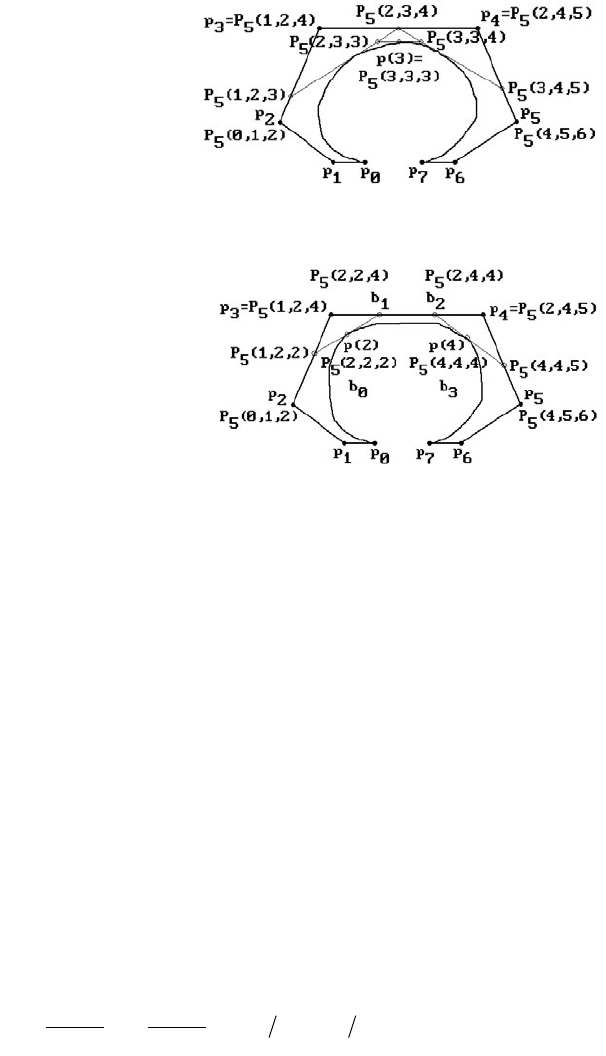
Figure 11.24 shows how Algorithm 11.5.2.2 computes the value of the cubic B-spline
p(u) with knot vector (0,0,0,0,1,2,4,5,6,6,6,6) at u = 3. In that case, i = 5 and p(3) =
P
5
(3,3,3).
There is more geometry hidden in the formalism above. Given a blossom we can
use equations (11.90) and (11.96) to define the Bézier and de Boor points, respectively.
In other words, we have a way to switch between a Bézier and a B-spline represen-
tation for a B-spline curve. We show how this works with an example.
11.5.2.11 Example. Let p(u) be a cubic B-spline p(u) with knot vector (t
i
) =
(0,0,0,0,1,2,4,5,6,6,6,6) and consider the interval [2,4]. Using the notation of Theorem
11.5.2.9 that interval corresponds to the values j = 5, k = 4, and 2 £ ᐉ £ 5. In equation
(11.90) we would have d = 3. Using the blossom of the curve p(u) over [2,4] = I
5
=
[t
5
,t
6
] we can compute both the associated de Boor points p
2
= P
5
(0,1,2), p
3
= P
5
(1,2,4),
p
4
= P
5
(2,4,5), and p
5
= P
5
(4,5,6) and the Bézier points b
0
= P
5
(2,2,2), b
1
= P
5
(2,2,4),
b
2
= P
5
(2,4,4), and b
3
= P
5
(4,4,4). See Figure 11.25. From this it is easy to see the rela-
tionship between the Bézier and de Boor points. Consider the three points p
3
=
P
5
(1,2,4) = P
5
(t
4
,t
5
,t
6
), b
1
= P
5
(2,2,4) = P
5
(t
5
,t
5
,t
6
), and p
4
= P
5
(5,2,4) = P
5
(t
7
,t
5
,t
6
). Using
barycentric coordinates and the linearity of P
5
with respect to its first coordinate, we
see that
Similarly, b
2
= P
5
(4,2,4) = P
5
(t
6
,t
5
,t
6
), and
bpppp
1
75
74
3
54
74
434
34 14=
-
-
+
-
-
=
()
+
()
tt
tt
tt
tt
.
11.5 B-Spline Curves 427
Figure 11.24. The de Boor algorithm for
B-splines using blossoms.
Figure 11.25. Computing Bézier points
from the de Boor points.

In particular, the points p
3
, b
1
, b
2
, and p
4
are collinear. Furthermore, the point b
1
divides the segment [p
3
,p
4
] in the same proportion as t
5
divides the interval [t
4
,t
7
].
Similarly, the point b
2
divides the segment [p
3
,p
4
] in the same proportion as t
6
divides
the interval [t
4
,t
7
].
The computations in Example 11.5.2.11 easily generalize. There was nothing
special about our knots and j = 5. Consider an arbitrary cubic B-spline p(u) with knots
t
j
and control points p
i
. With respect to [t
j
,t
j+1
], t
j
< t
j+1
, we have
Define points
Then we can easily show like in Example 11.5.2.11 that
and
11.5.2.12 Theorem. If t
j
£ u £ t
j+1
, then the cubic curve traced out by the function
p(u) defined by equations (11.95) and the curve traced out by the Bézier curve p(u)
defined on [0,1] by equation (11.49) for control points b
3j-6
, b
3j-5
, b
3j-4
, and b
3j-3
are
the same.
Proof. This is an easy consequence of the validity of the de Casteljau and the de
Boor algorithms.
Theorem 11.5.2.12 can be rephrased as saying that each cubic B-spline curve can
be thought of as a collection of cubic Bézier curves. Comparing control points, each
knot interval contributes two de Boor points and four Bézier points under this
correspondence.
The de Boor algorithm also shows us how to insert knots. The reason one might
want to insert knots is to allow more flexibility in subsequent manipulations. As usual,
assume that we have a B-spline p(u) of order k with knot vector K = (t
0
,t
1
,...t
n+k
)
defined by equation (11.95) and suppose that we want to add a new knot t, where t Œ
(t
h
,t
h+1
). Let K* = (t
0
,t
1
,..., t
h
,t,t
h+1
,..., t
n+k
) be the new knot vector and let N
*
i,k
(u)
be the spline functions defined recursively by equations (11.69) but with respect to
the new knot vector K*. We want to find new control points p
i
*
so that
bpp
34
21
21
2
11
21
1j
jj
jj
j
jj
jj
j
tt
tt
tt
tt
-
++
+-
-
+-
+-
-
=
-
-
+
-
-
.
bpp
35
2
21
2
1
21
1j
jj
jj
j
jj
jj
j
tt
tt
tt
tt
-
+
+-
-
-
+-
-
=
-
-
+
-
-
bb
bb
36 35 1
34 11 33 111
j jjjj j jjjj
j jjjj j jjjj
Pttt Pttt
Pttt Pttt
--+
- ++ - +++
=
()
=
()
=
()
=
()
,, , ,, ,
,, , ,, .
pp
jjjjj jjjjj
Pt tt and Pt tt
--+ -++
=
()
=
()
211 111
,, ,, .
bpppp
2
76
74
3
64
74
434
14 34=
-
-
+
-
-
=
()
+
()
tt
tt
tt
tt
.
428 11 Curves in Computer Graphics
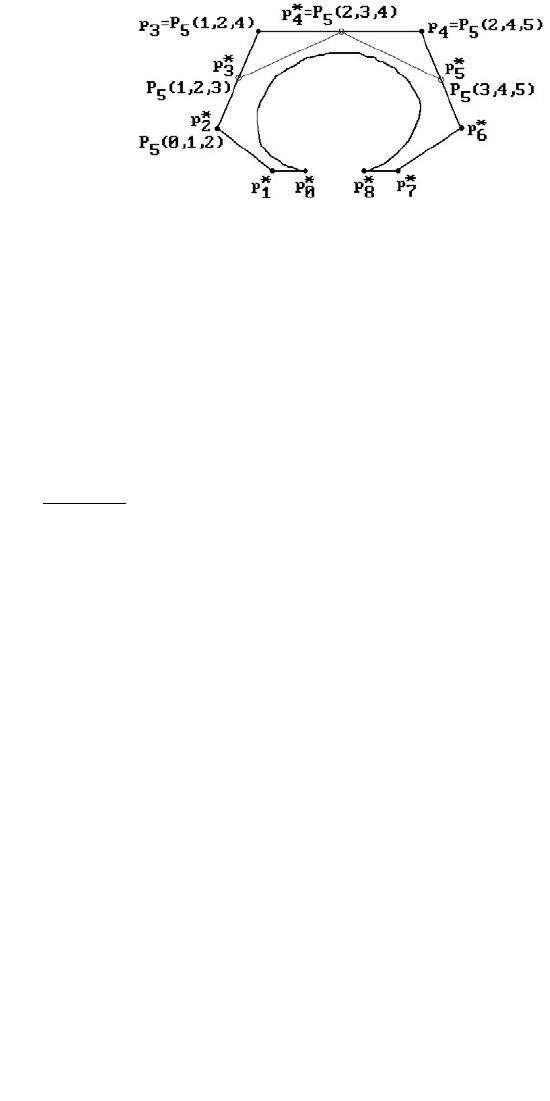
(11.97)
11.5.2.13 Theorem. The new control points for equation (11.97) are defined by
where
Proof. See [Boeh80] or [Seid89]. Figure 11.26 shows the idea behind the proof. We
have inserted the knot t = 3 into the knot vector (0,0,0,0,1,2,4,5,6,6,6,6) used in Figure
11.25.
Inserting knots does not change the shape of the curve but increases the number
of control points; however, in contrast to Bézier curves we do not raise the degree of
the curve by doing this.
Theorem 11.5.2.13 shows how to insert a single knot. Sometimes one wants to
insert more than one knot at a time into a knot vector. The next theorem shows how
to do that. We again assume that we have a B-spline p(u) with knot vector K = (t
0
,t
1
,
...t
n+k
), but this time we want to replace K with a new knot vector K* = (s
0
,s
1
,...,
s
m+k
), m ≥ n. If N
*
i,k
(u) are the spline functions associated to K*, we want to find the
new set of control points p
j
*
, so that
(11.98)
11.5.2.14 Theorem. (The Oslo Algorithm) The control points for equation (11.98)
are defined by
pp
j
ij
k
i
i
n
ajm
*
,,
,
=££
=
Â
0
0
pu N u
jk j
j
m
()
=
()
=
Â
,
**
.p
0
aihk
tt
tt
hk ih
hin
i
i
ik i
=££-+
=
-
-
-+££
=+££+
+-
10 1
2
011
1
,
,,
,
pp p
iii ii
aa
*
,=+-
()
-
1
1
pu N u
ik
i
n
i
()
=
()
=
+
Â
,
**
.
0
1
p
11.5 B-Spline Curves 429
Figure 11.26. Boehm knot insertion.

where the a
k
i,j
are defined recursively by
Proof. See [CoLR80].
We finish this section with several other theorems that follow easily from the
multiaffine map approach to splines. First of all, an important fact that drops out of
the formalism is the differentiability of the functions N
i,k
(u), which is not totally
obvious from their recursive definitions.
11.5.2.15 Theorem. If t = t
j+1
= t
j+2
= ...= t
j+m
is a knot of multiplicity m £ k for
N
i,k
(u), then N
i,k
(u) is C
k-1-m
at t.
Proof. See [Seid89].
11.5.2.16 Theorem. (Curry-Schoenberg Theorem) All splines are linear combina-
tions of B-splines.
Proof. See [Seid89].
One can use Theorems 11.5.2.12 and 11.5.2.15 to find the Bézier control points of
a spline of order k. Simply keep inserting knots until all have multiplicity k - 1. At
that point the de Boor points reduce to the Bézier points.
11.5.2.17 Theorem. (Variation diminishing property) A plane (line in planar case)
intersects a B-spline in no more points than it intersects the control polygon.
Proof. See [LanR83], [Seid89], or [PieT95]. In particular, this theorem applies to
Bézier curves.
One important point about all the results in this section is that the proofs are very
short and straightforward. The reader should have little trouble filling in those that
are omitted.
11.5.3 Rational B-spline Curves
Although B-splines curves represent a very large class of curves, they are unable to
represent some very simple curves exactly. It is easy to show that conics like circles
and ellipses cannot be represented by polynomial curves and so B-spline curves can
only approximate them. This is a drawback because conics are curves that one often
wants to represent.
Fortunately, all is not lost. Conics can be represented by rational curves via a
simple trick. We show how this works in the case of a circle. Consider the circle of
aiftst
elsewhere
a
st
tt
a
ts
tt
ar
ij
iji
ij
r
jk i
ik i
ij
r
ik jk
ik i
ij
r
,
,, ,
,,
,.
,.
1
1
1
1
1
1
1
1
1
1
0
1
=££
=
=
-
-
+
-
-
>
+
+-
+-
-
++-
++
+
-
430 11 Curves in Computer Graphics
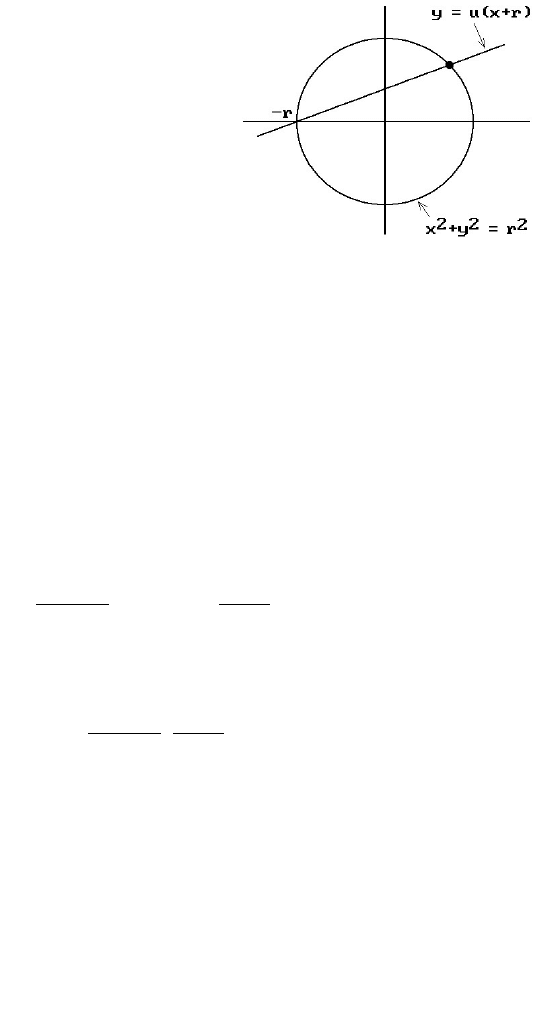
radius r shown in Figure 11.27. Every nonvertical line through (-r,0) can be
parameterized by its slope u and satisfies the equation
(11.99)
Solving for the intersection of this line and the circle
leads to the solution
and the parameterization
(11.100)
Another argument for showing that conics have rational parameterizations comes
about by using projective geometry and homogeneous coordinates. It is a well-known
fact (Theorem 3.6.1.1 in [AgoM04]) that all conics are projectively equivalent. In fact,
every conic X in the plane z = 1 in R
3
is the central projection of a parabola Y in some
other plane. See Figure 11.28. Furthermore, a parabola is the only conic that has a
polynomial parameterization. Now the standard parabola y = x
2
in R
2
can be
parameterized by u Æ (u,u
2
), so that our parabola Y can be parameterized by a
quadratic curve
(11.101)
since it is obtained from the standard one by a linear change of variables and such a
transformation does not change the degree of the parametrization. It follows that the
conic X has a rational parametrization of the form
uxuyuzuÆ
() () ()()
,,
u
ru
u
ru
u
Æ
-
()
++
Ê
Ë
Á
ˆ
¯
˜
1
1
2
1
2
22
,.
x
ru
u
and y
ru
u
=
-
()
+
=
+
1
1
2
1
2
22
xyr
222
+=
yuxr=+
()
.
11.5 B-Spline Curves 431
Figure 11.27. Defining a rational parameterization of
the circle.
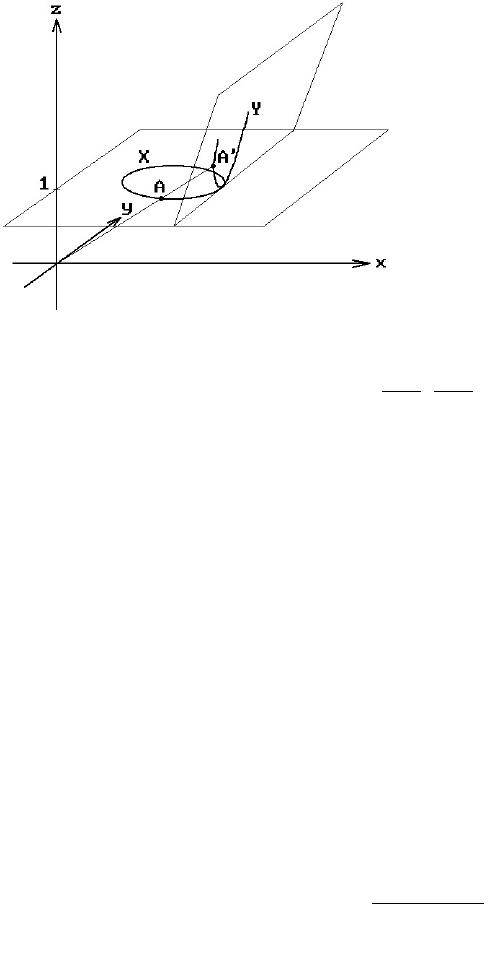
because the central projection is gotten simply by dividing by the z-coordinate. But
we can think of equation (11.101) as defining a conic with homogeneous coordinates
in projective space P
2
. The important observation is then that conics do have
polynomial representations if we use homogeneous coordinates.
In summary, we have shown that we can handle a larger class of curves if we use
homogeneous coordinates. In that setting, the analog of equation (11.67) is
(11.102)
where the b
i
(u) are suitable basis or blending functions and the P
i
are points described
with homogeneous coordinates. Everything we did earlier for polynomial curves
applies to the curves defined by equation (11.102) since the nature of the coordinates
did not play a role. In particular, we have the obvious notions of Bézier and B-spline
curves for homogeneous coordinates. Furthermore, if we write P
i
in the form P
i
=
(x
i
w
i
,y
i
w
i
,z
i
w
i
,w
i
), then the projective space curve defined by P(u) projects to the curve
(11.103)
where p
i
= (x
i
,y
i
,z
i
). There are several important special cases of such curves.
Definition. The curve p(u) defined by equation (11.103) is called a rational Bézier
curve if its domain is [0,1] and b
i
(u) = B
i,n
(u). (The B
s,t
(u) are the functions defined
by equation (11.50).) The curve p(u) is called a rational B-spline curve of order k if the
pu
wb u
wb u
ii i
i
n
ii
i
n
()
=
()
()
=
=
Â
Â
p
0
0
Pu b u
ii
i
n
()
=
()
=
Â
P ,
0
pu
xu
zu
yu
zu
()
=
()
()
()
()
Ê
Ë
ˆ
¯
,
432 11 Curves in Computer Graphics
Figure 11.28. Projectively equivalent
ellipse and parabola.

b
i
(u) are B-splines of order k. The curve p(u) is called a nonuniform rational B-spline
(NURBS) curve of order k with domain [a,b] if b
i
(u) = N
i,k
(u) with respect to a knot
vector
(The N
i,k
(u) are the B-splines defined by equations (11.69).) In any case, the points p
i
are called the control points of the curve p(u) and the numbers w
i
are called its weights.
The ordinary Bézier and B-spline curves are clearly a special case of the rational
ones since we get them by using weights that are all equal to 1. Note further that if
we define the function R
i
(u) by
(11.104a)
then
(11.104b)
so that p(u) is again a curve of a form (like that of equation (11.67)) that we have seen
many times before.
Definition. The functions R
i
(u) in equations (11.104) are called the rational basis
functions for the curve p(u).
NURBS curves (and surfaces) have become very popular in recent years and a
number of modeling programs are based on them. Some general references for these
and rational Bézier curves are [PieT95], [Pieg91], [Fari95], [Roge01], or [RogA90]. In
the rest of this section we shall look at some examples and properties of NURBS
curves, leaving a discussion of how to compute them efficiently to the next section.
11.5.3.1 Example. Suppose that we want to find a NURBS representation for the
unit circle.
Solution. Consider the first quadrant of the unit circle. By equation (11.100) we have
the rational parameterization
In homogeneous coordinates this can be written as
(11.105)
Pu u u u
uu
()
=- +
()
=
()
+
()
+-
()
1201
1001 0200 1001
22
2
,,,
,,, ,,, ,,,.
pu
u
u
u
u
for u
()
=
-
++
Ê
Ë
Á
ˆ
¯
˜
Œ
[]
1
1
2
1
01
2
22
,, ,.
pu R u
ii
i
n
()
=
()
=
Â
p ,
0
Ru
wb u
wb u
i
ii
jj
j
n
()
=
()
()
=
Â
0
,
U u a auu ub b
i
k
kk n
k
=
()
=
+
( ,..., , , ,..., , ,..., ).
1243412434
1
11.5 B-Spline Curves 433
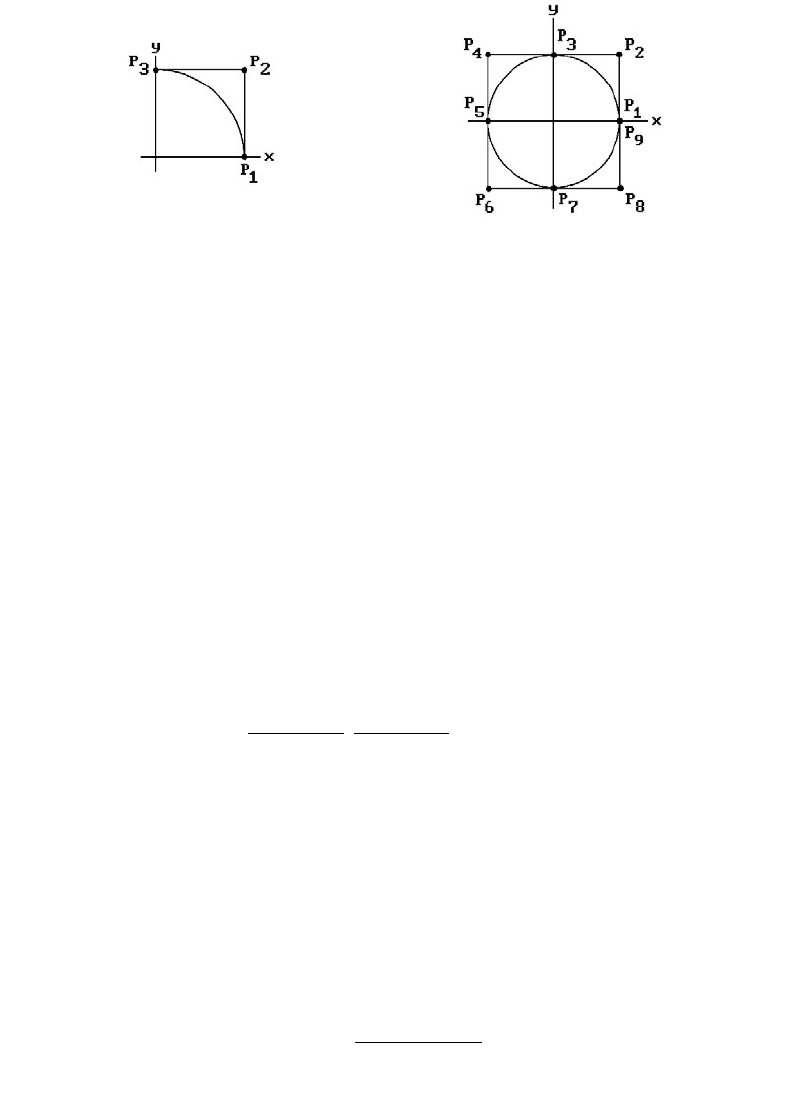
The Bézier approach to describing this curve is to look for three homogeneous control
points P
1
, P
2
, and P
3
so that
(11.106)
Equating the coefficients of the u’s in the two equations (11.105) and (11.106) for P(u)
gives that
The corresponding p
i
are shown in Figure 11.29(a). Using these P
i
as control points
and the knot vector (0,0,0,1,1,1) gives us the NURBS curve that describes the first
quadrant of the unit circle. A NURBS representation for the second quadrant can
easily be obtained from this one by rotating the control points about the y-axis by
180 degrees. Alternatively, reparameterizing to [1,2], a parameterization q(u) for this
second quadrant is
and we can solve for the new control points as before. At any rate, the new control
points are
Finally, rotating our control points by 180 degrees about the x-axis gives us the com-
plete NURBS representation for the whole unit circle. It is easy to check that the
parameterization can be written in the form
pu
wN u
wN u
ii i
i
ii
i
()
=
()
()
=
=
Â
Â
,
,
,
3
1
9
3
1
9
p
PP P
34 5
0202 1101 1001=
()
=-
()
=-
()
,,, , ,,, , ,,,and
qu
uu
uu
u
uu
for u
()
=
-+
-+
--
()
-+
Ê
Ë
Á
ˆ
¯
˜
Œ
[]
2
22
43
45
22
45
12,, ,,
PP P
12 3
1001 1101 0202=
()
=
()
=
()
,,,, ,,, , ,,, .and
Pu u u u u
uu
()
=-
()
+-
()
+
=+ -
()
+-+
()
121
22
2
12
2
3
121
2
321
PPP
PPPPPP.
434 11 Curves in Computer Graphics
Figure 11.29. The circle as a rational B-spline.
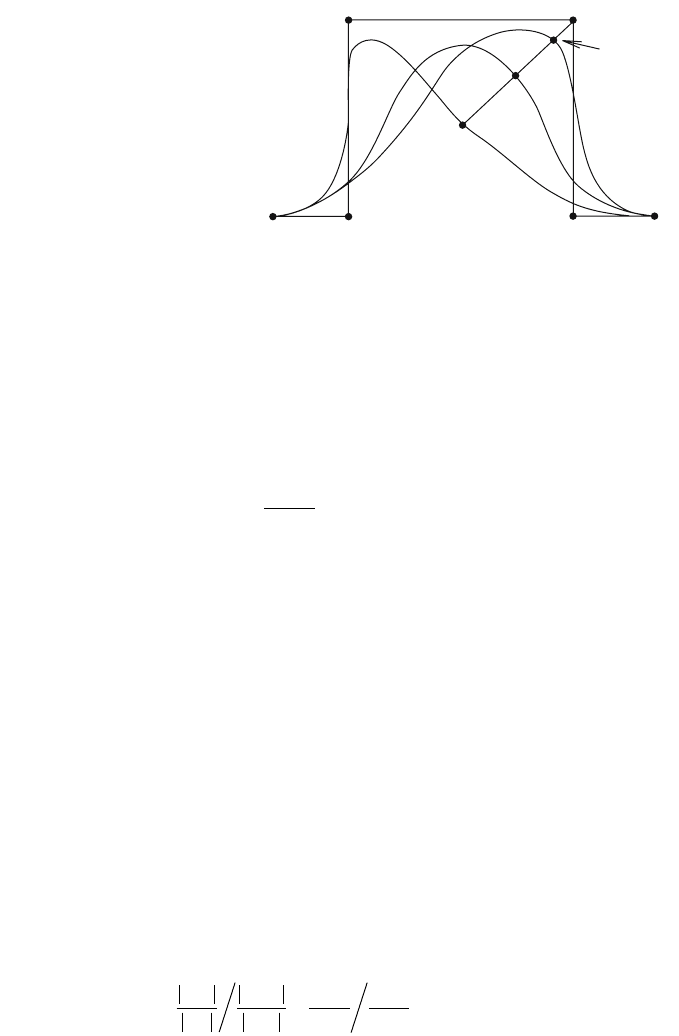
where the weight sequence (w
1
,w
2
,...,w
9
) is (1,1,2,1,1,1,2,1,1) and the knot vector is
(0,0,0,1,1,2,2,3,3, 4,4,4). The points p
i
are shown in Figure 11.29(b).
Although Example 11.5.3.1 found a NURBS representation for the unit circle, it
is not a good one because it does not distribute points uniformly along the circle. The
problem is with the rational function parameterization that we used as a starting
point. [Till83] shows how one can get a better parameterization by a rational trans-
formation of the form
Next, there is a geometric interpretation of the weights. To emphasize the depend-
ence of the function p(u) defined by equation (11.103) on its weights we shall include
a reference to the weights in the parameters of the functions below along with any
values that may have been assigned to them. See Figure 11.30, where
If
where the R
i
are the rational basis functions of p(u), then one can show that
It follows that
In other words, the weight w
i
is just the cross-ratio of the four points p
i
, q, r, and q
i
.
The following geometric facts can be proved:
w
i
iii
i
==
--pr
qr
pq
qq
11a
a
b
b
.
rqp
qqp
=-
()
+
=-
()
+
1
1
aa
bb
i
ii
and,
.
ab==
()
=
()
R u w and R u
ii i
;,1
qr q==
()
==
()
=π
()
p u w p u w and p u w or
iiii
;, ;, ; .01 01
u
at b
ct b
=
+
+
.
11.5 B-Spline Curves 435
p
1
p
2
p
3
q
3
q
r
p
0
p
5
p
4
Figure 11.30. The geometric interpreta-
tion of rational B-spline
weights.

(1) Increasing or decreasing w
i
will increase or decrease b which pulls the curve
toward p
i
or pushes it away from p
i
, respectively.
(2) Increasing or decreasing w
i
will push the curve away from p
j
or pull it toward
p
j
, j π i, respectively.
(3) The points q
i
lie on the line segment [q,p
i
].
(4) As q
i
approaches p
i
, b approaches 1 and w
i
approaches infinity.
We finish by listing a few of the important properties of NURBS curves.
11.5.3.2 Theorem. Let p(u) be a NURBS curve of order k with domain [0,1], knots
u
i
, control points p
i
, and weights w
i
> 0.
(1) The rational basis functions R
i
(u) for p(u) satisfy R
i
(u) ≥ 0 and
(2) The curve p(u) interpolates the first and last point. More precisely, p(0) = p
0
and p(1) = p
n
.
(3) (Local control) Changing the control point p
i
or weight w
i
only changes the
formula for p(u) over the interval (u
i
,u
i+k
).
(4) (Projective invariance) If the curve p(u) is transformed by a projective trans-
formation, the formula for the new curve is gotten simply by transforming the homo-
geneous control points (equation (11.102) and then projecting back to R
3
to get
another formula like equation (11.103).
(5) (Local convex hull property) The curve p(u) satisfies a strengthened convex
hull property like the ordinary B-splines, namely, for each i, p([u
i
,u
i+1
]) is contained
in the convex hull of the control points p
i-k+1
, p
i-k+2
,..., p
i
.
(6) (Variation diminishing property) A plane (line in planar case) intersects the
curve p(u) in no more points than it intersects the control polygon.
Proof. See [PieT95]. The projective invariance property is stronger than affine
invariance. Ordinary B-splines are affinely invariant but not projectively invariant.
Finally, although rational Bézier and B-spline curves are defined as projections
of ordinary Bézier and B-spline curves in R
4
to the plane w = 1, it turns out that the
associated correspondence between ordinary splines in R
4
and ordinary splines in R
3
is not as natural as one might want. For example, not every C
1
Bézier and B-spline
curve p(u) in R
3
with simple knots is a projection of a spline curve q(u) in R
4
with
simple knots. To find a curve q(u) that projects to p(u) we would have to allow q(u)
to have multiple knots. See [Fari89] for a discussion of this and the condition that
guarantees that a C
1
curve with simple knots is a projection of a C
1
curve with simple
knots.
11.5.4 Efficient B-Spline and NURBS Curve Algorithms
As mentioned earlier, B-spline and NURBS curves are used a lot. Fortunately, although
their definitions seem somewhat complicated and it is certainly more work than
Ru
i
i
n
()
=
=
Â
0
1.
436 11 Curves in Computer Graphics
